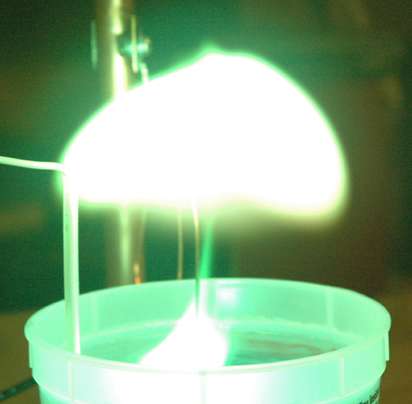January 17, 2014 report
First instance of ball lightning captured on video and spectrographs

(Phys.org) —Researchers in China have captured, for the first time, an instance of ball lightning, on digital video along with spectrographs. The accidental capture, detailed by the team in a paper they've had published in Physical Review Letters, offers proof that ball lightning does exist and because it was captured via spectrographs also, offers clues as to how it came to exist.
People have been reporting instances of ball lightning for as long as people have been able to communicate. But until now, because of their rarity no one has ever managed to capture one on tape—that the researchers also captured data on spectrographs only adds to the specialness of the event.
The researchers report that they were not out to capture video of ball lightning, instead, they were video-taping lightning strikes as part of a genera research effort. As they were recording, a ball lightning event occurred right in front of their camera. They report that it came into being just off the ground, travelled for about five meters before rising slightly higher and traveling for another fifteen meters before disappearing. The entire event last just over a second and a half.
More importantly, the researchers were also recording with spectrographic equipment which allowed them to discern the main elements that made up the ball. They found them to be iron, silicon and calcium, the very same main ingredients in soil.
Back in 2000 James Dinniss and John Abrahamson suggested in a paper that ball lightning was likely a result of normal lightning striking the ground. The immense heat, they suggested would be enough to cause silicon oxide in the soil to vaporize—the shockwave from the bolt would then push the gas up into the air where it would begin to glow as it was oxidized in the atmosphere. Six years later Vladimir Dikhtyar and Eli Jerby created what appeared to be ball lightning in a lab by following up on the ideas expressed by Dinniss and Abrahamson. The information from the spectrographs captured by the Chinese team appears to back up the theory as well.
The researchers that caught the ball lightning on video also reported that there was a slight anomaly—an intensity fluctuation at about 100 Hz, which they suggested may have been due to the influence of nearby power lines.
More information: Observation of the optical and spectral characteristics of ball lightning, PRL, Accepted Monday Dec 16, 2013. prl.aps.org/accepted/ac07eY2cQ … 90317bc60f3d7e42e93c
Abstract
A ball lightning (BL) has been observed with two slit-less spectrographs at a distance of 0.9 km. The BL is generated by a cloud-to-ground lightning strike. It moves horizontally during the luminous duration. The evolution of size, color and light intensity is reported in detail. The spectral analysis indicates that the radiation from soil elements is present for the entire lifetime of the BL.
Journal information: Physical Review Letters
© 2014 Phys.org




















